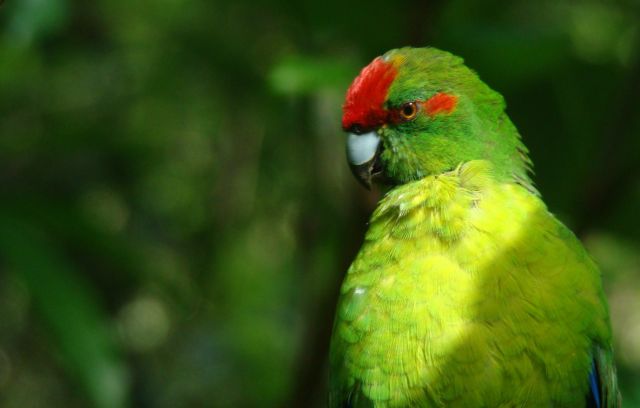Kakariki to be released at Tawharanui this Sunday
Kakariki to be released at Tawharanui this Sunday

13 March 2009
Kakariki, or red-crowned parakeets, are the latest addition to the open sanctuary at Tawharanui Regional Park. These birds, which haven’t been seen on the Auckland mainland for around a century, will be released on Sunday 15 March.
About 20 kakariki will be released into the Tawharanui Open Sanctuary, joining other recently released species, North Island brown kiwi and the rare pateke (brown teal).
A ‘top up’ of numbers will be done in late April, to bring the number of kakariki released this year to around 40.
“Releasing 40 kakariki here means we will have a sufficient founder population to establish the birds at Tawharanui,” says ARC open sanctuary coordinator Matt Maitland.
“From there, we hope these bright, cheerful and chattery birds will disperse across the park and, as the population grows, move further afield.
“Like so many of our native species, kakariki were once common and widespread but are now almost exclusively restricted to offshore islands. They are a flocking bird, meaning that visitors to Tawharanui will come across groups of them when exploring the park – these bright and showy birds with their cheeky chuckle and chatter will be hard to miss!” he says.
These kakariki come to the Tawharanui Open Sanctuary from Hauturu (Little Barrier Island) and are part of an ongoing translocation project being carried out by Massey conservation doctoral researcher Luis Ortiz-Catedral.
Mr Ortiz-Catedral’s work also includes releasing kakariki on Motuihe Island. Birds released on Motuihe in May 2008 have already established and begun breeding.
Mr Ortiz-Catedral, who is based at Massey's Institute of Natural Sciences in Albany, says that the habitat features at Tawharanui and current pest management plans will allow this species to thrive and will be the first parakeet population open to the public at a mainland site.
“Kakariki have been translocated to offshore islands within the last 40 years but the only documented translocation of the species to a mainland site in 1990 failed. Such failure is attributed to limited predator control at the release area,” he says.
The kakariki is the most widespread and variable parakeet species in New Zealand. It formerly occupied North, South and Stewart Islands but presently occupies a much reduced and fragmented distribution, mostly on offshore islands free of mammalian predators.
Kakariki use diverse nesting sites, form breeding pairs at an early age and can lay up to 16 eggs within a single breeding season. They also feed on numerous plant and animal species and can travel long distances. These features make them successful colonizers of islands throughout the South Pacific.
Interestingly, kakariki were once found in such large numbers that they were culled as orchard pests.
This release has been made possible with the support of Ransom Wines. The Tawharanui Open Sanctuary Society Inc (TOSSI) and Ransom have established a sponsorship arrangement where $1.00 from each bottle of Ransom K-Syrah 2007 is contributed to TOSSI for kakariki protection.
“Ransom Wines’ contribution to this project is greatly appreciated,” says TOSSI Deputy Chair Helen Crosby.
“It is heartening to see a local business taking an active interest in such a worthy project in their area. We hope that one day the cheeky kakariki will be visiting a Ransom vineyard!”
ENDS
The ARC and TOSSI partnership
• The Tawharanui Open Sanctuary is a community partnership between the ARC and the Tawharanui Open Sanctuary Society Inc.
• Tawharanui Regional Park is owned and managed by the ARC on behalf of the people of the Auckland region; it is one of 26 regional parks.
• TOSSI was formed in 2002 to assist with the development of the open sanctuary. It has raised over $400,000 toward the establishment of the predator proof fence and ongoing conservation projects in the sanctuary. TOSSI members volunteer thousands of hours each year; assisting with species monitoring, pest control, tree planting and habitat restoration.
Tawharanui Regional Park and Open Sanctuary
• The 588-hectare regional park is New Zealand's first integrated open sanctuary (mainland island) where farming, public recreation and conservation of native species combine.
• Tawharanui Regional Park is owned by the ARC and the open sanctuary is managed in partnership with the Tawharanui Open Sanctuary Society Inc (TOSSI).
• How to get there: Take State Highway 1 north to Warkworth. Follow the signs to Matakana. Just past Matakana turn right at the Omaha turn off, drive along Takatu Rd and the park is well sign posted. (Note: the last 6km of the route is a winding gravel road). Approx 90 minutes from downtown Auckland.
• For further information about Tawharanui Open Sanctuary go to www.arc.govt.nz or www.tossi.org.nz.
Photographs
• Attached photograph
shows a kakariki (red-crowned parakeet). Photo credit: Luis
Ortiz-Catedral.


 Vegetables New Zealand: New Web-Based Tool Will Help Greenhouse Growers Switch To Geothermal Heating
Vegetables New Zealand: New Web-Based Tool Will Help Greenhouse Growers Switch To Geothermal Heating Horizon Research Limited: New Poll - New Zealanders Prefer Rail Enabled Ferries
Horizon Research Limited: New Poll - New Zealanders Prefer Rail Enabled Ferries Watercare: Watercare Gets To Work On First Permanent Non-Potable Water Tanker Filling Station In Māngere
Watercare: Watercare Gets To Work On First Permanent Non-Potable Water Tanker Filling Station In Māngere Alcohol Healthwatch: Licensing Decision Lauded For Prohibiting Buy Now Pay Later Schemes In Bottle Stores
Alcohol Healthwatch: Licensing Decision Lauded For Prohibiting Buy Now Pay Later Schemes In Bottle Stores Motor Industry Association: Vehicle Registrations Up 5.6% In December, But Year-To-Date Sales Reflect Market Challenges
Motor Industry Association: Vehicle Registrations Up 5.6% In December, But Year-To-Date Sales Reflect Market Challenges BNZ: Depression-era Bequest Still Helping 88 Years Later
BNZ: Depression-era Bequest Still Helping 88 Years Later



